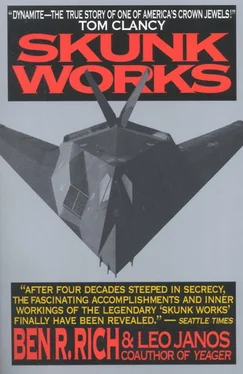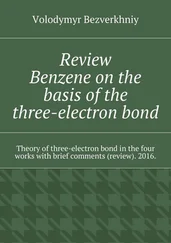We encouraged our people to work imaginatively, to improvise and try unconventional approaches to problem solving, and then got out of their way. By applying the most commonsense methods to develop new technologies, we saved tremendous amounts of time and money, while operating in an atmosphere of trust and cooperation both with our government customers and between our white-collar and blue-collar employees. In the end, Lockheed’s Skunk Works demonstrated the awesome capabilities of American inventiveness when free to operate under near ideal working conditions. That may be our most enduring legacy as well as our source of lasting pride.
A successful Skunk Works will always demand a strong leader and a work environment dominated by highly motivated employees. Given those two key ingredients, the Skunk Works will endure and remain unrivaled for advancing future technology. Of that, I am certain, even in the face of dramatic downsizing of our military-industrial complex. Prudence demands that the country retain a national capability to design and develop both new technologies and weapons systems to meet threats as they arise, especially better and improved surveillance of unstable, hostile regimes.
Nuclear proliferation is a growing menace: a bomb in the hands of the North Koreans, the Pakistanis, or the Iranians makes the world infinitely dangerous and demands the closest surveillance, which only the most advanced technology can provide. At last count there were about 110 local wars or potential trouble spots around the globe to keep a close eye on. Human conflicts may be smaller in size and scope in the post–cold war era, but certainly not in nastiness. Littoral confrontations—local conflicts caused by political, religious, or ideological differences—will probably monopolize international tensions and concerns for at least the remainder of this century. Increasingly, we will be facing small hostile countries armed to the teeth with the latest weapons technologies purchased from irresponsible outlets in Western Europe or from Russian, Chinese, or North Korean sources. A small country firing high-tech weaponry can do as much damage on the battlefield as a major power. Just remind the Russian high command of the tremendous losses of Hind helicopters they sustained in Afghanistan to a bunch of ragtag peasants firing shoulder-held Stinger missiles, supplied to them by our CIA.
Small localized conflicts are going to be played out on the ground by highly mobile strike forces requiring air superiority, overhead surveillance, and surgical air strikes with high-precision guided ordinance; and a Skunk Works that is expert at low rate production of startling new technologies will undoubtedly serve important national security purposes in the future as it has in the past.
Given current contractions in defense spending and needs, the mountainous inventory of big-strike weapons like intercontinental missiles will be sharply reduced and much of it scrapped. The remaining systems will need updating with the latest technologies, improved to reduce maintenance and manpower utilizations—perfect tasks for Skunk Works operations.
As regions of the world become increasingly unstable, the U-2 fleet might undergo its third reconfiguration in its five decades of service to the nation as our preeminent spy plane. And while that is happening a future successor of mine at the Skunk Works will undoubtedly be peddling ideas for solving technological problems arising out of nonuse of weapons—for example, how to keep silo-based missiles reliable and effective after years of sitting inert in the ground. In some cases reliability has dropped below 50 percent. Another big problem that a Skunk Works would be eager to try to solve is eliminating battlefield deaths caused by accidental friendly fire. Twenty-six percent of our battlefield deaths in Desert Storm resulted from our own shells and bullets. What is needed is some sort of foolproof technology, which the Pentagon has designated IFF—Identify Friend or Foe. The Army plans to spend nearly $100 million developing exclusive radio frequency signals that troops can use in the field at night (our GIs may give off a definite buzz), as well as infrared devices and paints on trucks and tanks that only our side can see using special lenses.
As the only remaining superpower, the United States will be wise to resist being drawn into any military intervention on the short end of public support or lacking a clear threat to our own national security. But even a leader able to whip up sentiment for “sending in the Marines” will find it dicey to undertake any prolonged struggle leading to significant casualties. New technologies will focus increasingly on developing non-manned fighting machines by using reliable drones, robotics, and self-propelled vehicles. As we proved in Desert Storm, the technology now exists to preprogram computerized combat missions with tremendous accuracy so that our stealth fighters could fly by computer program precisely to their targets over Iraq. A stealthy drone is clearly the next step, and I anticipate that we are heading toward a future where combat aircraft will be pilotless drones. On the ground and at sea as well, remote-controlled tanks and missile launchers and unmanned computer-programmed submarines and missile frigates will provide the military advantage to those possessing the most imaginative and reliable electronics and avionics. Field commanders can conduct battles and actually aim and fire weapons systems from the safety of control centers thousands of miles away—their targets sighted by the high-powered lenses aboard drone surveillance aircraft which they remotely control. This is not a Buck Rogers scenario; this is around the corner. Tomorrow’s most prized military breakthrough may be in the form of a dazzlingly new and powerful microchip.
The Skunk Works has always been perched at the cutting edge. More than half a dozen times over the past fifty years of cold war we have managed to create breakthroughs in military aircraft or weapons systems that tipped the strategic balance of power for a decade or longer, because our adversaries could not duplicate or counter what we had created. That must continue to be our role into the next century, if we are to preserve what we have accomplished and be prepared for the hazards as well as the opportunities for the uncharted, risky future.
EPILOGUE
THE VIEW FROM THE TOP
Harold Brown
(Secretary of Defense from 1977 to 1981)
I have thirty years’ worth of memories involving the Skunk Works, beginning in the late 1950s while I was at Livermore Laboratories helping out with interpretations of the Soviet nuclear program, which I based in significant part on information available to me that had been obtained by those historic U-2 overflights of Russia. I remember with much less relish May 1, 1960, and the following difficult days during which the story of the U-2—or at least a part of it—became public knowledge because of the shooting down of Francis Gary Powers. I remember coming to Washington early in 1961 as Director of Defense Research and Engineering and being briefed on the intelligence bonanza achieved by the earlier U-2 missions over Russia. I was amazed by the quantity and its strategic importance.
I was at the Pentagon when the U-2 again played a decisive role, this time during the Cuban missile crisis, obtaining photographs detailed enough to convince first the U.S. decision makers and then our allies of what the Soviets were up to in Cuba. Even though the credibility of our government was much higher in those days than it subsequently has become, I think it would have been extremely difficult for President Kennedy to carry the public and the allies along with him on the blockade and all its grave implications for nuclear war in the absence of the proof supplied by the U-2 photos.
Читать дальше












